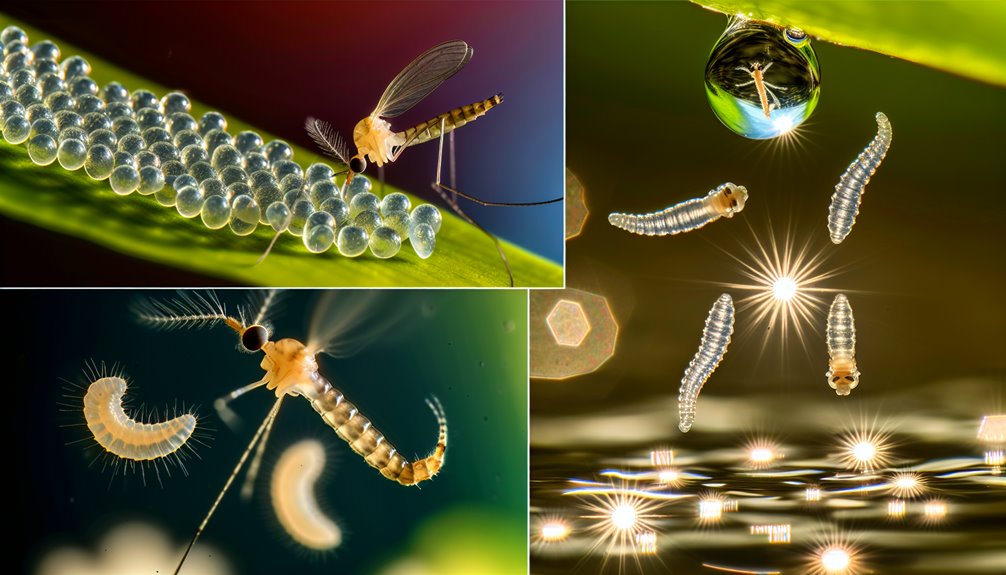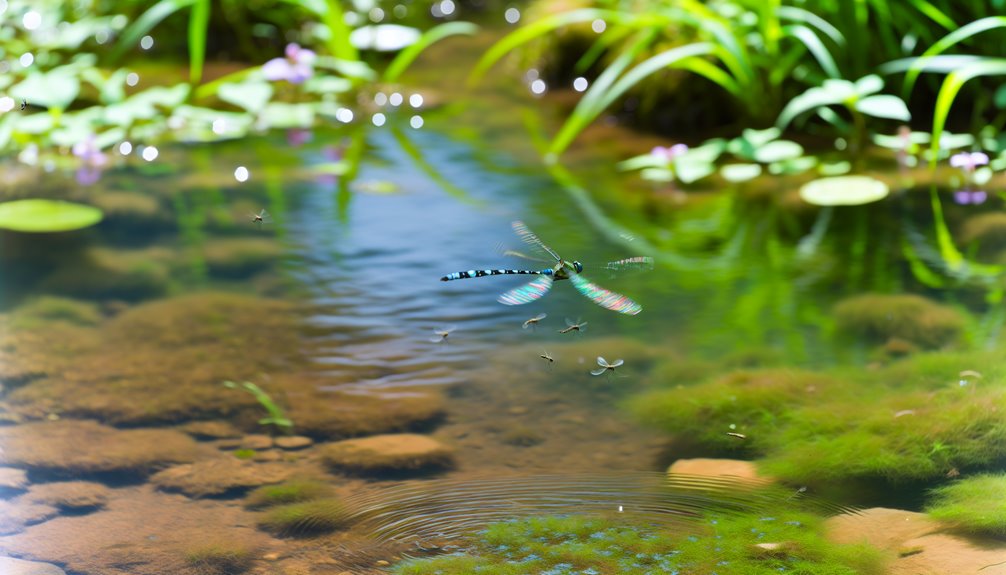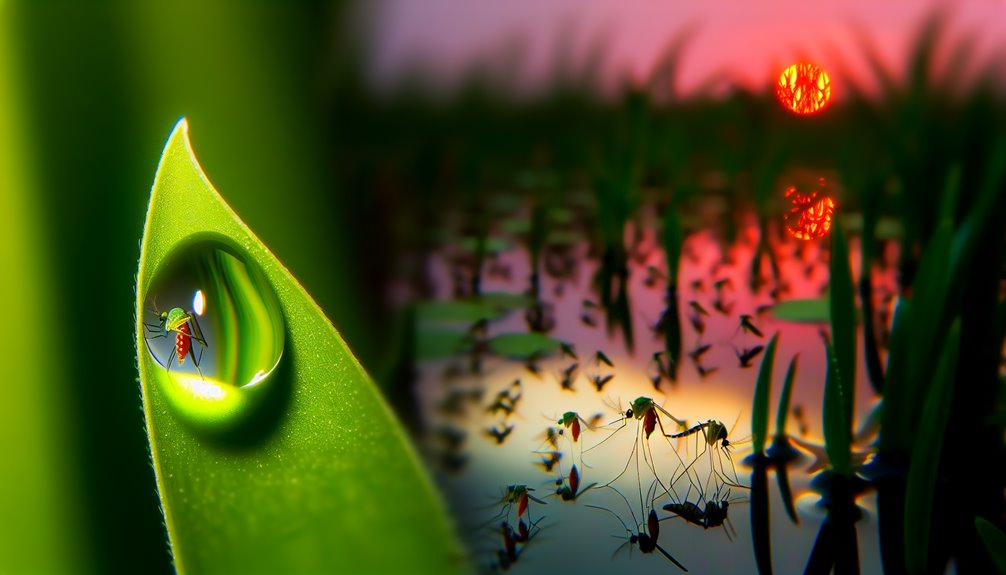When it comes to mosquito control, you might be surprised to learn that not all mosquitoes bite, and only females are responsible for spreading diseases. Understanding the lifecycle of these insects can help you implement more effective strategies. Additionally, natural predators play a critical role in managing populations, but that’s just the beginning. There are innovative and sustainable methods emerging that could change how we approach this persistent problem. What else could be influencing these tiny yet impactful creatures?
The Lifecycle of Mosquitoes: A Closer Look

When you consider the lifecycle of mosquitoes, it’s essential to understand that it unfolds in four distinct stages: egg, larva, pupa, and adult.
The process begins with egg development, where female mosquitoes lay eggs in or near standing water. These eggs typically hatch within 24 to 48 hours, depending on environmental conditions.
Once hatched, larvae emerge and thrive in various larval habitats, such as ponds, marshes, and containers, feeding on organic matter and microorganisms. This stage lasts several days to weeks, influenced by temperature and food availability.
Following the larval phase, they change into pupae, a non-feeding stage where they undergo metamorphosis.
Understanding these stages is vital for effective mosquito control strategies that serve communities and protect public health.
Not All Mosquitoes Bite: The Role of Males
While many people associate mosquitoes with the irritation of bites, it’s important to recognize that not all mosquitoes are blood-feeders; in fact, only female mosquitoes require blood to develop their eggs.
Male mosquitoes, on the other hand, have distinct feeding habits. They primarily consume nectar and other plant sugars, which provide the energy necessary for their activities.
This divergence in diet underscores the ecological role male mosquitoes play, as they contribute to pollination.
Understanding these differences is essential for effective mosquito control strategies. By recognizing that only females pose a biting threat, you can focus efforts on managing their populations, thereby reducing nuisance and disease transmission while appreciating the ecological contributions of male mosquitoes.
Natural Predators: Who Eats Mosquitoes?

Male mosquitoes may not pose a biting threat, but both genders contribute to the ecosystem, including serving as prey for a variety of natural predators.
Importantly, dragonflies are significant predators of mosquitoes. Their agile flight and remarkable hunting skills enable them to consume large quantities, providing dragonfly benefits that help regulate mosquito populations.
Similarly, numerous bird predators, such as swallows and purple martins, feast on mosquitoes, contributing to natural pest control.
The presence of these predators fosters a balanced ecosystem and reduces the need for chemical interventions.
Innovative Control Methods: Beyond Repellents
As traditional repellents face growing scrutiny due to their environmental and health impacts, researchers are exploring innovative control methods that offer sustainable alternatives.
One promising approach is genetic modification, where scientists alter mosquito DNA to reduce their populations or render them incapable of transmitting diseases. For instance, genetically modified mosquitoes can be designed to produce non-viable offspring, effectively controlling breeding rates.
Additionally, biological control methods leverage natural predators or pathogens to manage mosquito populations. Introducing specific fish species or bacteria that target mosquito larvae can create a balanced ecosystem, reducing reliance on chemical interventions.
The Impact of Climate Change on Mosquito Populations

Climate change greatly influences mosquito populations, altering their distribution, behavior, and life cycles. As temperatures rise, you’ll notice expanded habitats for these pests, allowing them to thrive in previously inhospitable areas.
The climate influence also accelerates their reproductive rates, leading to increased population dynamics. Warmer weather shortens development times from egg to adult, meaning more mosquitoes emerge faster, heightening the risk of disease transmission.
Additionally, changes in precipitation patterns can create more standing water, essential for breeding. Understanding these shifts is vital for effective mosquito control strategies.
Myths and Misconceptions About Mosquito Behavior
Understanding mosquito behavior is often clouded by myths and misconceptions that can hinder effective control efforts.
By debunking these, you can help promote better practices in your community.
- Mosquitoes aren’t attracted to light: Their primary lure is carbon dioxide and body heat, not bright lights.
- Standing water isn’t the only breeding site: They can reproduce in small containers, including plant saucers and clogged gutters.
- All mosquitoes bite: Only female mosquitoes require blood for egg development; males feed on nectar.
Conclusion
As the owner of Mosquito Eliminators of South MS, I truly believe that together we can create a healthier, more enjoyable outdoor space for everyone. Understanding the lifecycle of mosquitoes and the role of their natural predators is just the beginning. By embracing innovative control methods and being proactive, we can significantly reduce their impact on our lives. I invite you to join me in this journey towards a mosquito-free environment. Feel free to visit our website at mosquitoeliminatorsms.com or give us a call at (601) 336-2277. Let’s work together to reclaim your outdoor spaces and enjoy the beauty of nature without the nuisance of these pests!

